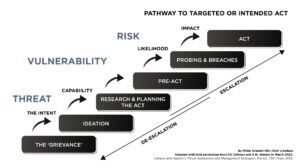Student nurse guilty of plotting Isis-inspired hospital bomb attack.
Whenever we read a story of an attack, we need to remember that the perpetrators haven’t just snapped and decided to act, they have brooded, planned and prepared before the attack.
The journey they travel is well represented by The Pathway to Violence, a model created by Frederick Calhoun and Stephen Weston and is fundamental to the science of behavioural threat management.

The steps along the journey are:
- Grievance
- Ideation
- Research and Planning the Act
- Pre-Act
- Probing and Breaching
- The Violent Act
Mohammad Farooq was found guilty of preparing acts of terrorism at Sheffield Crown Court this week. He had previously pleaded guilty to other serious offences related to his planned attack at his workplace, St. James Hospital, Leeds.
Farooq is an excellent example of someone who started with a grievance and escalated along the “Pathway”.
Farook had a grievance against several of his former colleagues and, fuelled by perceived “bullying” at work had been conducting a poison pen campaign against them. His grievance developed into a violent ideation where he had planned to “kill as many nurses as possible” by detonating a pressure cooker bomb.
His plan was driven by his grievance against his colleagues and associated with his “extremist Islamic ideology” in which he “sought his own martyrdom” through a “murderous terrorist attack”.
His research and planning included obtaining bomb-making instructions in a magazine published by al Qaida together with internet searches for night-vision goggles. It also included him identifying his initial target, when he planned to attack RAF Menwith Hill, a spy base operated by US and UK staff. Traffic cameras showed he made a series of reconnaissance trips to RAF Menwith Hill, but switched targets after finding it was too well guarded.
He diverted his attention to his place of work, St James Hospital in Leeds.
The process of building a bomb, securing binoculars, and preparing for the act was the pre-act phase.
He sent a bomb threat to the ward where he worked, hoping to cause an evacuation, and then planned to detonate the bomb in the crowd outside. This can be seen as part of breaching or it may be seen as part of the wider plan. However, the nurse he contacted was off-duty that day and it was another hour before she saw his text message and acted on it.
The delay forced Farooq to change his plans and he instead decided to set off his homemade device in the hospital cafe.
As he waited for a shift change to maximise the number of casualties, he was spotted by patient Nathan Newby.
Newby, listened to his intuition which told him that Farooq’s body language suggested he was in crisis. He approached Farooq and over the next few hours he talked with Farooq and slowly persuaded him to hand himself in, and in doing so, prevented the attack.
Thankfully on this occasion the planned act of extreme violence was prevented.



